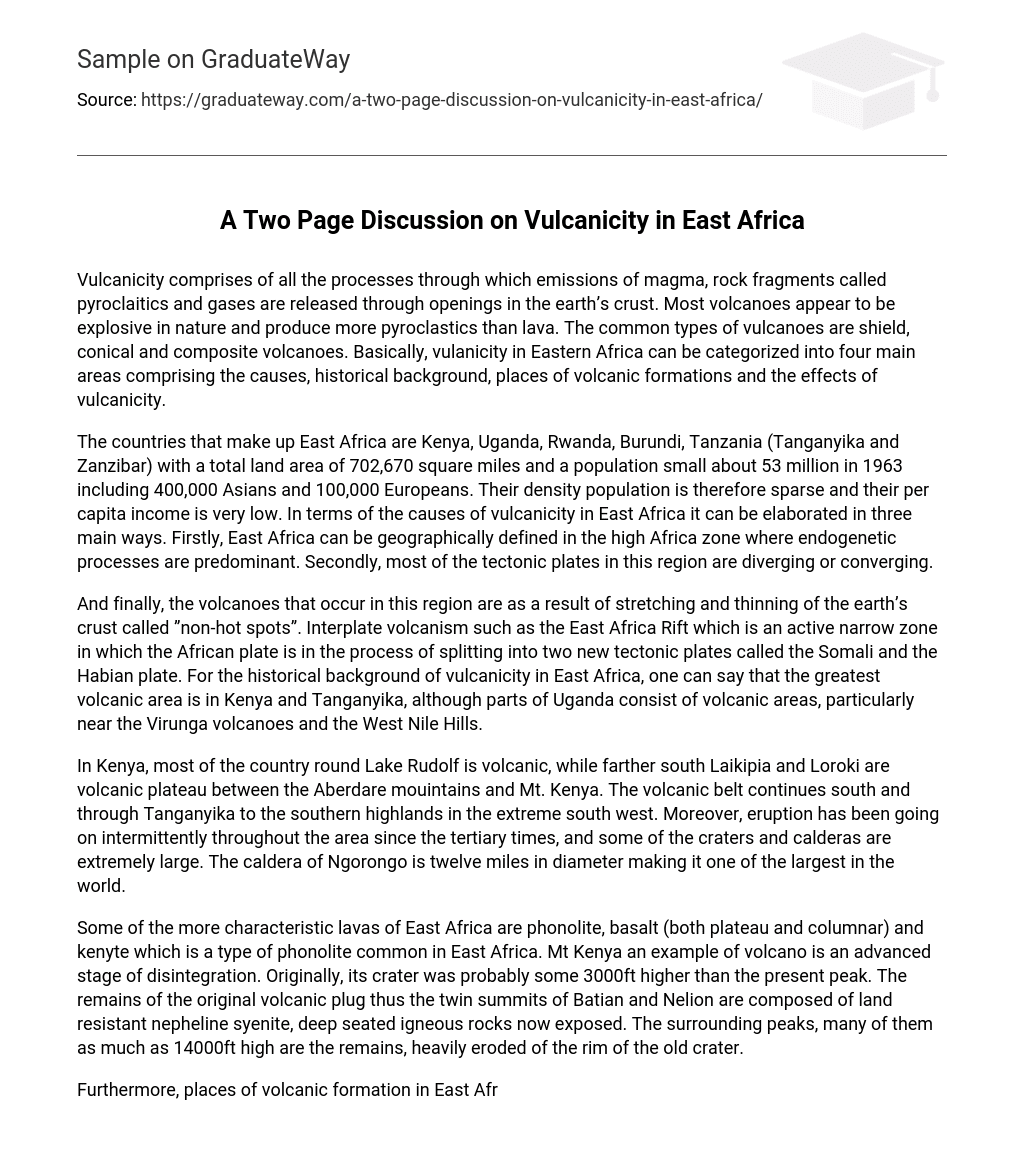Vulcanicity encompasses several processes where magma, pyroclaitic rock fragments, and gases escape through fissures in the earth’s crust. These processes give rise to volcanoes, which are primarily characterized by their explosive eruptions and the ejection of pyroclastics rather than lava. Various types of volcanoes exist such as shield, conical, and composite volcanoes. In Eastern Africa, vulcanicity is categorized into four main areas: causes, historical background, locations of volcanic formations, and the consequences of vulcanicity.
East Africa consists of several countries, including Kenya, Uganda, Rwanda, Burundi, and Tanzania (which includes Tanganyika and Zanzibar). The total land area of this region is 702,670 square miles. In 1963, the population was approximately 53 million, which included around 400,000 Asians and 100,000 Europeans. Despite its large land area compared to its small population size, East Africa has low population density and per capita income. Vulcanicity in this region can be attributed to three main factors: firstly, its location within the high Africa zone where endogenetic processes dominate; secondly, the presence of diverging or converging tectonic plates.
In summary, the volcanoes in this region are formed due to the stretching and thinning of the earth’s crust referred to as “non-hot spots”. The East Africa Rift is an example of interplate volcanism, where the African plate is dividing into two new tectonic plates – the Somali and Habian plates. Kenya and Tanganyika have the largest volcanic areas in East Africa historically, but there are also volcanic regions in parts of Uganda near the Virunga volcanoes and the West Nile Hills.
Lake Rudolf in Kenya and its surrounding areas are predominantly volcanic. To the south, Laikipia and Loroki are volcanic plateaus nestled between the Aberdare mountains and Mt. Kenya. This volcanic belt stretches further down to Tanganyika and reaches the southern highlands in the extreme southwest. Over time, intermittent eruptions have occurred throughout this region since tertiary times, leading to the creation of extensive craters and calderas. Among them, Ngorongo caldera stands out as one of the largest globally with a diameter spanning twelve miles.
Some of the distinctive lavas found in East Africa include phonolite, basalt (both plateau and columnar), and kenyte, which is a common type of phonolite in the region. Mount Kenya, an example of a volcano, is currently in an advanced stage of disintegration. It is believed that the volcano’s crater was originally approximately 3000ft higher than its present peak. The twin summits of Batian and Nelion, which are composed of resistant nepheline syenite, are the remains of the original volcanic plug that has now been exposed. The surrounding peaks, many of which reach heights of up to 14000ft, are heavily eroded remnants of the rim of the old crater.
In addition, the East Africa region contains volcanic formations on both sides of the Rift Valley. Notable volcanoes in this area include Mt Kilimanjaro at 14,340ft, Mt. Kenya at 17058ft, tlgon at 14778ft, Meru at 14979ft, and Virunga(Mbifanbro) volcanoes at 14786ft near lake Kiru. Most of these volcanoes are currently inactive, with the exception of occasional activity from Ol’Donyo Lengair volcano near Lake Natron in Tanganyika. The effects of vulcanicity in this region primarily include lava flows, ash flows, lateral blasts, ash falls, and the emission of hazardous gases into the earth and its atmosphere.
Secondary effects of the primary consequences, including mudflows, flood fires, and tsunamis, disrupt human activities such as sanitation and farming. These disruptions have led to severe famine, disease outbreaks, property damage, and population displacement in East Africa. However, vulcanicity in Eastern Africa has resulted in economic growth for countries like Kenya, Tanganyika, and Tanzania. This growth can be attributed to popular tourist destinations like Mt Kilimanjaro – Africa’s highest peak – as well as Mt Kenya and the Ngorongoro caldera which is one of the world’s largest.
To mitigate the effects of volcanic devastation in East Africa, it is essential for authorities to move the local residents and inhabitants residing in volcano-prone regions to safer areas. This measure acknowledges the uncertain nature of volcanic eruptions while considering the geomorphic processes and alterations that take place in the high Africa zone.
References:
The text consists of a link to the website “http://www.geosc.psu.edu/~jrogie/ans11-3.html” and a reference to the book “Africa and the Islands” authored by Harrison, Clarke, Clarke, and Henderson. The book was published in Great Britain by Spottiswoode, Ballautyne and Co.





